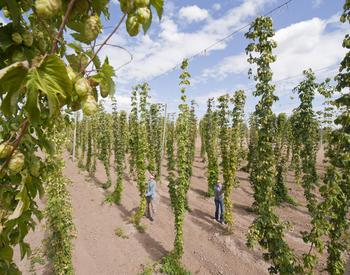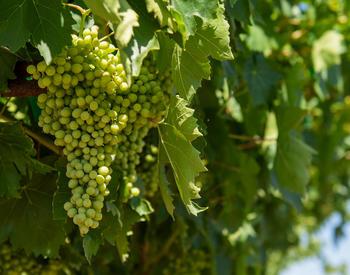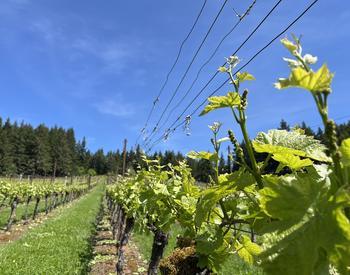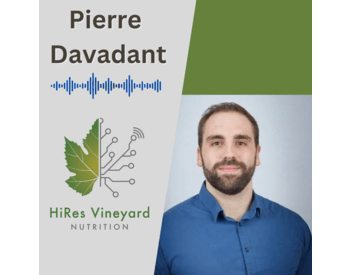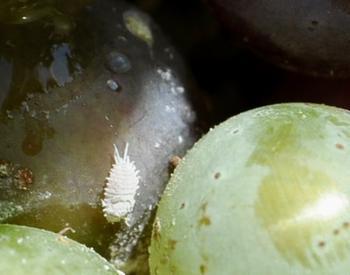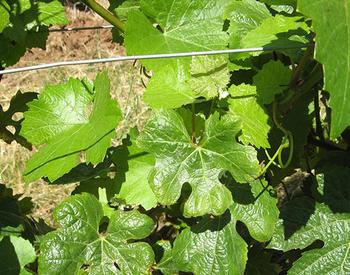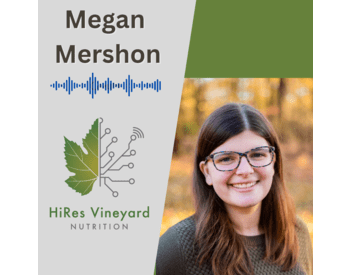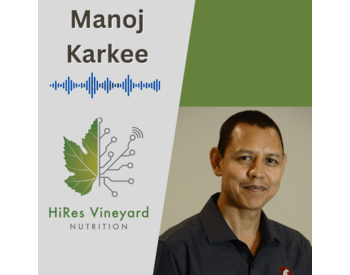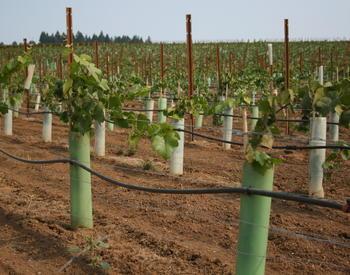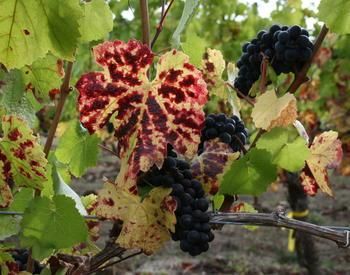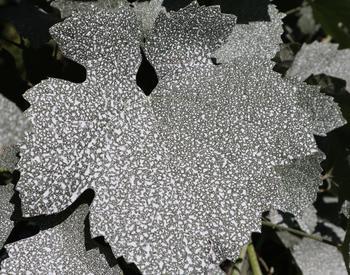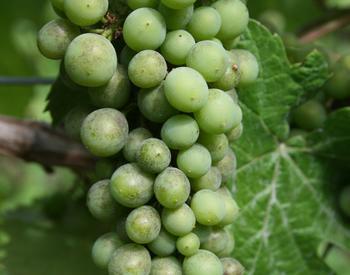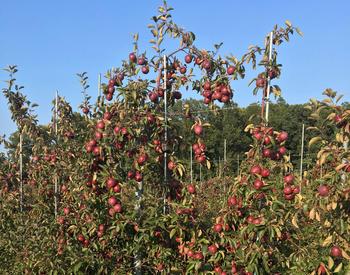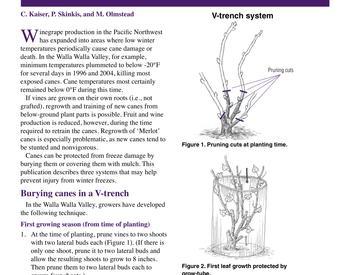Transcript
000 Patty Skinkis
This is the High-Res Vineyard Nutrition Podcast Series, devoted to helping the grape and wine industry understand more about how to monitor and manage vineyard health through grapevine nutrition research. I am your host, Dr. Patty Skinkis, Professor and Viticulture Extension Specialist at Oregon State University.
022 Patty Skinkis
Grapes are grown in nearly all states of the United States, and we recognize that grape production can vary across diverse climates that encompass all of those wine growing regions in our nation. We also recognize that grapevines may not perform similarly in all of those climates or under the demands of different grape markets. Throughout this podcast I've interviewed researchers on different types of grapes from table grapes to juice grapes to wine grapes, and I've had some conversations about vineyard nutrition in other regions of the United States. However today we're going to focus specifically on Eastern US Viticulture and the work being done in Virginia specifically on grapevine nutrition.
Many of the listeners out there likely have heard of Dr. Tony Wolf. He's a prominent viticulturist and who recently retired from Virginia Tech. He did many decades of work on various aspects of viticulture from vineyard floor management to rootstocks and grapevine nutrition. He was prolific as an extension viticulturist, making his research accessible to others across the northeast [US] and across other areas of the United States. Thankfully, viticulture research is strong and active in Virginia today, and we have with us Dana Acimovic, who is going to talk to us about some of the work that they are continuing to do in grapevine nutrition research for Virginia and that is likely relatable to other areas of the northeastern and eastern United States.
Dana is a research associate with ten years of experience working in the field of viticulture and fruit growing. She is a member of the viticulture team at Virginia Tech and is located at the Alson H. Smith Jr Agricultural Research and Extension Center in Winchester, Virginia. She works with the Plant Nutrition and Product Quality focus group within the HiRes Vineyard Nutrition Project and has goals to understand nutrient levels necessary for optimum vine growth, including development of new or revised protocols for plant nutrient analysis. Part of her work is also to understand the nutrient thresholds for sufficiency and deficiency in grapevines in the context of Virginia as well as the context of the larger projects within the HiRes Vineyard Nutrition Project.
Thanks for joining us today, Dana.
Can you tell us a little bit about yourself and how you got started in viticulture research?
02:46 Dana Acimovic
Thank you for having me, Patty. Yes, of course. As you mentioned before, I'm a research associate in the viticultural lab at Virginia Tech. I graduated in Serbia, College of Agriculture at the University of Belgrade, and my major was in fruit growing and viticulture. After graduation, I work for some brief period of time in the apple industry, and in 2010, I was a visiting scholar in the viticulture lab at MSU [Michigan State University]. After that work, I just decided to apply for the graduate program. I really liked MSU, you know—the campus and people--Michigan was my second home. So, I got accepted, and I always had an interest in plants and their physiology, especially grapevines. That's my favorite plant. I decided, for my masters [degree], I would focus on the source-sink relationships and we used Pinot noir to test the effect of leaf pulling on cluster architecture and its susceptibility to Botrytis bunch rot. After I graduated, for some time I also worked with the plants, but in 2016 I started my engagement with Cornell's Hudson Valley Research Lab in New York State. Over there I was an Extension Specialist. I did work with grapes, but majority of my work was related to some research in apples and cherries. For example, we tested different planting systems and rootstocks. I had multiple experiments with precision thinning in apples, precision pruning, then an irrigation trial. I also did some research on the tools for the suppression of sunburn damage on apple fruit, and I also did some work in the entomology lab. So, I helped develop strategies for the biocontrol of Brown Marmorated Stink Bug, which was the huge pest [problem] in New York state. And, as you mentioned earlier, I started my engagement with Virginia Tech in 2021, and since then, I was working on this High-Resolution Vineyard Nutrient Management Project. But besides that, I also collect some data on the grapevine variety trials over here. And I'm also taking a small part as an advisory board member in the Virginia Resistant Variety. That's a really interesting breeding project which goal was to create V. vinifera – like varieties but they should be suitable for Mid -Atlantic [US] region and really resistant to a fungal pathogens. So that's all the areas I covered in in the past ten years.
06:05 Patty Skinkis
Wow, you have a lot of background in varied areas of viticulture but not only viticulture. I'm sure that the perennial cropping work in tree fruits has also been really helpful. Very neat. I didn't know about all the diverse background you had. That's fantastic.
06:17 Dana Acimovic
Yes. Yeah.
06:23 Patty Skinkis
Now, given all of that you know, and the background and perspective you have, can you tell us a bit about your role in the HiRes Vineyard Nutrition Project? What have you done over the past few years?
06:38 Dana Acimovic
Yeah, sure. So, I started in 2021, and I worked under professor Tony Wolf when I joined the project. They already had all trials set up in commercial vineyards. And the viticulture team had started to collect some data on nutrient content in leaf tissue. My role back then was to take over all responsibilities in terms of research conduct. I also had to write reports, you know, communicate our research finding to the grower audience and to the other researchers. A couple months after I started this project, actually I joined to the project, Tony announced that he would be retiring in January [2022]. So, I took an official role as a project co-PI which added to my current research responsibility some administration work. So, you know, it sometimes looks like a boring job but sometimes it's quite interesting, especially the part that I took in last March when we organized the annual HiRes meeting in Virginia. So, I helped our project director, Nataliya, to organize that meeting, and I just used this opportunity to call people who make it to Virginia and spend two days with us. That was our first official fully in-person meeting after the project started. I hope everybody had a great time as I did, and I honestly hope that our next annual meeting will last a little longer than two days. This two days seems like being quite intense.
08:23 Patty Skinkis
So, I'm glad you brought up the annual meeting because, for those of you listening, we as research teams are called to meet in person or at least meet as frequently as we can. This project, the HiRes Vineyard Nutrition Project, started during the pandemic-- so it started in 2020, so it was really challenging to get a large national team together. And, like Dsna said, our first fully in-person meeting--no online version available—was in Winchester, Virginia. So, for many of us, it was our first time to see that research station, the first time to Winchester, Virginia, and we were--I think a lot of us were--amazed at the landscape and just how much Vitis vinifera is being grown [in Virginia]. And so, we had some tours included, so it was great for the national team to all be there in Virginia and to learn more about the wine industry as well as learn more from each other in the project. We do a lot of things online, but it's nice for hopefully people to know we still are communicating as a research team interpersonally as well.
Yeah, so I know that the research that you're doing is really quite interesting, and I want you to share with the listeners about what the main questions of the research that you're conducting are and how you approached those questions.
09:55 Dana Acimovic
Right, so with this project, we do a couple of trials, and we have multiple objectives. However, I would say that our main objective is to define a quantitative relationship between tissue nitrogen concentration and wine capacity, and for that we use Chardonnay. As you may know, Chardonnay is a Vitis vinifera variety, and it's commonly grown in Virginia. But, there is another problem, there are other hybrids also grown over here, and we want to know whether there is any differences between a hybrid variety, such as Chardonel, and as a benchmark we need for various varieties such as Chardonel in respect to the relationship to nitrogen.
So besides that, we also are looking into the plant tissue—actually, we are trying to figure out which plant tissue could be systematically used with high confidence as a good indicator for the overall nitrogen status in the plant, and in that regard we are testing which tissue if petioles, for example, or leaf blades, can better reflect the range of applied nitrogen. So far, both petioles and blades are commonly used for diagnostics and each of them has its pros and cons, and there is like this constant battle for which is better to use. However, in this research, we're also interested in berries too. Since berries accumulate nitrogen as well. You probably know about it since this work will be based on your and Paul’s [Schreiner] previous research that points to the link between nitrogen in leaf blades and YAN [yeast assimilable nitrogen] at veraison. So, that's why we would like to see whether the veraison YAN level can be used as an overall indicator of vine nitrogen status.
There is another set of trials that will help us explore tissue sampling time of the day and its impact on vine tissue nutrient concentration, especially nitrogen. So, you know when you set some guidelines when to sample, whether the time of the day actually have any impact on that. We know that usually people sample at bloom and veraison, but what exact time should they go into the vineyard and sample? Should that be morning, noon, evening? This question was previously partially explored, and the indication is that sampling time might not play a major role in the humid-subtropical areas. So I'll talk about that later, I guess. Our preliminary results are actually point to exactly that. And what else? Ah yes, our final objective or just the part of this program is to use our Virginia test sites for ground-truthing of remote sensing work. So, we have Terry Bates from Cornell visiting our trial at the AREC [research station]. We have one trial at the research station but he also made a trip to a commercial vineyard in our area and he did some NDVI and soil scans, and those are uploaded to My Efficient Vineyard application. We also spoke to the grower and taught him how to actually use and apply the [MyEV] app and how to use it to update the new tissue results that he was getting from there. Other members of his team…. they should come over and fly the hyperspectral cameras or use a multispectral system with ours. They're trying just to select the right wavelength that would correspond to the nutrient level in the in the leaf tissue. So basically, those are our objectives in terms of the Virginia team.
14:47 Patty Skinkis
It's great that you've been able to be a part of basically all of the primary goals of the project to do your own research, to test out the protocols and ask new questions of the protocols that we currently use for sampling, and then also to have the precision Agriculture Tool teams to be applying those to the site. So that's fantastic to hear. I have a couple follow-up questions with the Chardonnay and the Chardonel being able to use as models for the impact or differences--the vine nutrient response of a Vitis vinifera. So, the Chardonnay as the V. vinifera variety and then the Chardonel is the hybrid. Do you see major vine vigor or vine growth differences between Chardonnay and Chardonel?
15:39 Dana Acimovic
Yes, yes and Chardonel is, I would say, a plant that all vineyard beginner growers like—those that are new to growing grapes. They should go with [that variety] at least here in in Virginia. It's super easy to grow. It's quite resistant. It's quite vigorous, and it's a robust, and it gives like a high yield almost constantly. So, I would really like recommend Chardonel. I mean even when you compare Chardonel to Chardonnay, Chardonnay is kind of you know those like a nice fragile toy that you really have to pay a lot of attention to get the right fruit. But Chardonel you can grow easy.
16:35 Patty Skinkis
That's a great comparison. I’ve already talked to Megan Mershon about the Chardonnay and Chardonel through her end of this work and that's one question I didn't have for her, of course she's a food scientist rather than a horticulturist. That's great context to be able to understand the two big differences. So, you're expecting some differences there for the nutrient monitoring. Then one of the questions I have for the sampling--the tissue sampling. First of all, I thought it was brilliant, the timing of day. I always assume there's not really much of a difference and people just go out and collect it. So, when you came up with a time of day, how did you decide what to test? Do you have a sense for what growers were doing in terms of time of day or did you have a feeling for what direction or a hypothesis of what direction might be preferable like morning versus afternoon?
17:35 Dana Acimovic
Yes, so I would scientifically, from the scientific point of view I would rather use really early pre-dawn sampling but you know commercially, that's not really realistic to expect the grower to get there 3:00 AM and start sampling. So, that's why we decided to do our samples at 8 AM, noontime and just 4 hours later like 4:00 PM. Just comparing the morning versus afternoon samples, if there is any difference, I think we should see it right there. So, I think that that is the huge timeframe to observe any difference.
18:20 Patty Skinkis
Can you describe some of the work and how you've done the work so far? Perhaps describe some of the projects and you can do it individually maybe start out with treatments being applied to their Chardonnay versus the Chardonel.
18:33 Dana Acimovic
Yes, both Chardonnay and Chardonel would receive the same treatments. We originally had two locations. In commercial vineyards one with Chardonnay the other one which Chardonel, and we have two treatments which was soil nitrogen application and foliar nitrogen application. Our soil nitrogen application had three levels in which we expose plants with non-nitrogen as a low level, or medium level of nitrogen, or which would be thirty three kilograms per hectare and then we use the high rate of nitrogen for the third level, which would be 65 kg per hectacre since that's the high dose we would split that those in two applications, one would be applied at bloom like the medium application and the other would be applied four weeks later. Foliar application, we used urea and we would apply urea at veraison, and this foliar treatment also had two levels where we either do not apply any foliar treatments, or apply urea at the rate of 5 pounds per acre. So, overall the design of the experiment is a split plot design with our main factor as a soil application and as subfactor the foliar application. Then, after we apply treatments, we would collect some data. we would collect leaf tissue; we would collect blades and petioles and keep those data separate the time points when we do that is full bloom, veraison and two weeks post-veraison, just to see if there's any effect of the foliar application. Then at the same time, we would do the chlorophyll content index measurements with a handheld unit [SPAD meter]. We would do it at the same time when we do sampling, so it was bloom, veraison and two weeks post-veraison.
We also develop a protocol for berry samples with Amanda Stewart to analyze YAN and to analyze specific amino acids. So, her recommendation was to start sampling two weeks post-veraison and we would do like two weeks post-veraison, four weeks post-veraison and at the harvest. Of course, once the grower start picking the grapes at a commercial harvest point, we would record yield per vine, cluster count per vine and other [yield] parameters. We would also record pruning weight after we finish the pruning. I just want to add to this the diurnal leaf and berry tissue samples for this particular objective when we testing does it matter what time of the day we do sampling we would collect leaves. But, blades and petioles and we would collect berries at veraison and as I mentioned earlier that would be 8 a.m., noon, and four p.m.
22:08 Patty Skinkis
So, you did both berries during that time too?
22:11 Dana Acimovic
Yes, at veraison so that's we decided just to go with a one time point. As you know, preparation for that sampling is quite complex because we wanted to make sure that our vines are not under water stress. Then I would, you know, make sure that all vines get enough irrigation before we start sampling and exclude that variable from the equation.
22:39 Patty Skinkis
When you did the analysis of the berries were they handled similarly to the leaf blades and the petioles like dried and…?
22:46 Dana Acimovic
We are not drying berries, if that's your question. We are sending berries to Amanda [Stewart’s] lab and they're going to be processing the same way for like regular YAN analysis and amino acids. So, we're not just you know looking at all the nitrogen content. We are looking at YAN.
23:04 Patty Skinkis
OK, that makes sense much more sense. Ok so, what are your findings so far from this project?
23:10 Dana Acimovic
Okay, so that's a fun question because right now we're in the middle point regarding our data collection. So, I wouldn't call any of our findings major findings or rather like suggestive. We do not have like a full set of data for Chardonnay. We had a misfortune with the Chardonnay trial where we lost a couple of data on yield crop load-- harvest data. For two years in a row just because, you know, it's hard to keep one healthy. In this region, last year for example, we got two inches of rain within a few days and those events were just, happening during the entire season. I can ask growers, to stay the whole time on the tractors. You know, staying on the top of their spraying program and just a slight mistake can lead to some problems that you can later on fix. Anyhow, we are trying to repeat those trials, but so far, we do have a full set of data on Chardonel yield component.
After the first year of the nitrogen application. We didn't see much effect, neither on yield or pruning weight. The vines were quite vigorous well- maintained before the start of the project, so you wouldn't expect to see any influence of nitrogen. That even happened in the following year, but with the small differences, we start noticing changes in the cluster weight, besides that we didn't observe any differences in the fruit quality or anything else. So, the foliar application, that's also something that we didn't see much impact on the yield components, fruit quality or pruning weight in the last two years. When we compared plant tissue—we do have data on Chardonnay and Chardonel at this point for that matter. We saw that both Chardonnay and Chardonel leaf blades at veraison they better reflected the range of applied soil nitrogen. So, blades responded better than the petioles and that's something that we've been seeing before and which I also expected to see here.
26:12 Dana Acimovic
Also, our measurements of the chlorophyll content Index at veraison pointed to the same direction. We see that those numbers are higher with a higher rate of nitrogen. Interestingly enough, I didn't see any differences with foliar nitrogen applications. So, even when we come later after the foliar application has been done and measure a CCI on the leaves. You don't see any differences then what I mentioned earlier that the tissue sampling time of the day. We do have data on leaves not on berries, We didn't see any impact on Chardonnay and Chardonel. Both of them respond the same way, doesn't really matter when you come to sample the leaves. Here I want to just point out that we are sending leaves for the analysis, and those issued analysis include all macro- and micronutrients. So, I did process data regarding the nitrogen, but I'm still processing the entire set of data. So, I might find some interesting results, especially regarding some highly mobile elements. They might result with some differences.
27:39 Patty Skinkis
So that's a good disclaimer to say on the results of the time of day analysis that you've just looked at nitrogen at this point. So yeah, more to come on some of that other work. I think probably even though you mentioned you didn't necessarily have a full data set on the Chardonnay, you still have a lot of data you could still work with.
27:57 Dana Acimovic
Definitely, yes, I just want to see those yield components that are missing and see how our treatments are affecting them. But in terms of tissues, we pretty much know what to expect.
28:11 Patty Skinkis
And the vines you're working with are they own rooted or are they on rootstock? And what rootstock are they?
28:15 Dana Acimovic
They are on rootstocks--all of them. Yes.
28:18 Patty Skinkis
And what rootstock are they?
28:20 Dana Acimovic
I cannot tell right away; I do have some somewhere written the rootstocks, each trial has its own set of different rootstocks, and it's not just one but multiple.
28:32 Patty Skinkis
Do they tend to be like 3309 and 101-14? I I figured probably also Riparia gloire?
28:43 Dana Acimovic
Correct. Yes.
28:45 Patty Skinkis
Yeah, just for the context of those listening, I figured that's probably the case. Certainly, no unrooted vines. So, what are the next steps for the work that you're doing?
28:56 Dana Acimovic
Yeah, so, officially we still have a season and a half [2023-2024] in front of us before this project ends. During this period theoretically, we should compile all necessary data points. For example, our enology team has a late start in this project. They're currently working on YAN and amino acid profile analysis. So that's a work in the progress and after we get that piece of information, we can compare it with our leaf sample results. Then we have that issue with the Chardonnay trials. But thanks to you and your suggestion, we decided to reorganize the trial and to use actually two different locations instead of you know just to compensate for the lost years. So, we are using our research trial at AREC, and we are using another commercial vineyard. That would help us you know gain all information we need until the end of the project.
302 Patty Skinkis
I think Donna brings up a good point that a lot of times when we're doing viticulture research and we're at the mercy of the limits of both our grower collaborators as well as the growing seasons. We try to make the most out of duplication or replication over time or space. So just catching up with replication across space rather than time to fill in the gaps and where some of that was lost previously.
I know in research in nitrogen has been going on a lot of people think that grapevines don't need a lot of nitrogen, especially in areas where there's high rainfall even here in Oregon. A lot of growers are really afraid of applying nitrogen. So, what do you think? Or maybe you can tell us a little bit about how growers in Virginia and other areas of the mid-Atlantic or the Eastern U.S.--How do they typically manage nitrogen and how will this research help them better manage nitrogen in particular?
31:03 Dana Acimovic
What I can see now talking with growers, and I'm also a part of the Sentinel Vineyard Program which would gather all major grape growers in the area and bring to the table once a month they would express their concerns and observation in the vineyard. So, I can exactly see what people think of many different areas of grape growing. So, what I can notice is that they're eager to use nitrogen especially if they see in early in the season that leaves are pale. So, I do get those questions. Why is this happening? For example, last year actually, this winter was quite harsh. We did have a couple of freezing events a couple of weeks before the actual bud break and that had a huge impact. I think that reduced our shoot counts and cluster counts and everything. Then once the growth started you know, quite weak with the pale leaves. Then continuing to the super dry season and when you have those conditions that are not really favorable for a nutrient uptake. People started to worry. So, I do have growers who like to apply foliar urea, for example, at bloom and some of them applied it around the bloom and you know they really want to see whether those applications are doing something. The questions I get for example, when can I see the results of my bloom application or can I see it by veraison? So yeah, those are the things, and I think this project will definitely benefit [the growers]. They will have some kind of guidelines to better rely on than they would have it now because all we have is just petiole data. So, we don't have any blade data, and we know that petiole data they are not quite good for the nitrogen recommendation.
33:43 Patty Skinkis
So, nitrogen is an issue and especially in variable growing seasons. I’m sure that's a good point you bring up. In variable growing seasons, they can't just do practices as normal, and I think that speaks to this climate change concern.
33:59 Dana Acimovic
All correct.
34:01 Patty Skinkis
So yeah, that's a good point that this will be able to be useful and also the growers are wanting to do the foliar urea earlier. Was the foliar urea added early in the season as well?
34:14 Dana Acimovic
No, we did a foliar at veraison. We only apply the soil [N treatments] at bloom.
34:18 Patty Skinkis
Do you think there was any ramifications [of the grower] of doing a foliar urea at bloom?
34:24 Dana Acimovic
It definitely wouldn't make it worse, so it’ll make those nitrogen easily available to the plant. So yeah, I would say would definitely be for that.
34:40 Patty Skinkis
And it sounds like it was a definite deficiency situation at that point.
34:45 Dana Acimovic
Oh yes, this this year was quite a year, yes.
34:49 Patty Skinkis
So, it's dry all around. It's been dry here. It's been dry in the Midwest.
34:53 Dana Acimovic
Only unlike the previous one when we were, you know, under a flood constantly.
34:58 Patty Skinkis
What do you think in terms of the work-- it's very nice because this project is very directly linked to a lot of the fruit quality work that is being done by Amanda Stewart's lab at Virginia tech. What do you think are the impacts on YAN that's going to be the most hopeful for growers? Do they typically see pretty low YAN levels?
35:21 Dana Acimovic
Well, some of them do. It really depends on the growing system they're using. So, people who tend to grow cover crop or grass beneath the vines, they constantly have low YAN and it would be like around hundred (100 mg/L) or below. So yeah, those are the ones that I would say suffer from the low YAN. Some typical locations, like historically known for low YAN, I know a couple of vineyards that would have like certain varieties with constant low YAN. Sometimes it's good to know where to find those varieties just to you know have it for the research trials is a base standard with low YAN.
36:19 Patty Skinkis
I think that's another good point you bring up is that not any region has completely uniform situations when it comes to nutrition. So, we have that here in Oregon as well where some vineyards are low YAN, low nitrogen while others are very vigorous and it's all a combination of soil type and rootstock, what they're using, cultivar that they're growing. So yeah, it's hard to make [generalizations].
36:40 Dana Acimovic
Correct. Yeah, we see that diversity even in terms of phenological stages. So, just vineyards that are you know next to each other. They see a huge difference in phenology even though they're the same you age. So, it's kind of you know, really interesting point. Some you know when we get a rain some more vineyards get constant rain, some being constantly avoid by rain and it's really diverse.
37:13 Patty Skinkis
Well, thank you for talking about your work. I want to wrap up with a fun question. So, what is the most interesting course that you've ever taken in your educational path and why.
37:24 Dana Acimovic
All right, so I thought about this, and I decided to say it was statistics. Here's the catch-- I mean I really hated statistics in my undergraduate study. Probably because we didn't have an inspiring statistician professor who would show us a bigger picture behind the statistics. However, that all changed when I started my graduate program at Michigan State [University], and again thanks to an excellent professor who was originally a soil scientist, but she taught herself statistics and she taught us how to apply statistics for biologists. So, I would say that was ultimately the most useful course I have ever taken. And you know, now that people are talking about artificial intelligence (Chat GPT), you know you have to keep in mind that you know statistics is base work of all those machine learning systems. So yeah, that's something that I really like to do. Especially when I get a huge set of data. It’s kind opening of this snack or some chocolate bar. You know I start eating it like little by little-- that's how much I really enjoy working on statistics.
38:53 Patty Skinkis
Now that is great. I think most of us who do research, we love statistics from the standpoint of being able to see our data. Okay, we've just spent all this time getting all this data. What does it have to say and really, it's the objectivity of it--where we want the numbers to speak. And not just whatever our hypothesis might have been, so I hear you there I really enjoy…
39:17 Dana Acimovic
Exactly! You know I would also hear from professors like, oh what do you see in the field, like do you see any differences. No, I don't see any differences until I run statistics. I don't want to say anything that is not completely objective.
39:36 Patty Skinkis
Yeah, absolutely. It’s so important to have somebody who is inspiring, like you said. I remember my stats professor, he was a forester and then another one worked with fish. It's always kind of interesting to hear their backgrounds that they give through their research projects, and you get to learn some very dry but funny humor from statisticians.
403 Patty Skinkis
Well thank you so much for joining us today, Dana. it's been a pleasure to learn about the work being done in Virginia and the work that's still to come and the results from the work. I hope everybody who is listening will be able to tune in to see what some of the results will be in the future. And, if you want to learn more about the HiRes Vineyard Nutrition Project, you can visit our website at https://highresvineyardnutrition.com, and we're also on Instagram, LinkedIn and Twitter.
440 Dana Acimovic
Thank you, Patty.
Do grape cultivars have different responses to nutrients? Do we need to sample different tissues based on cultivar? Does the time of day matter for tissue sampling? In this episode, Dana Acimovic of Virginia Tech’s Viticulture Team describes the research to address these questions.
